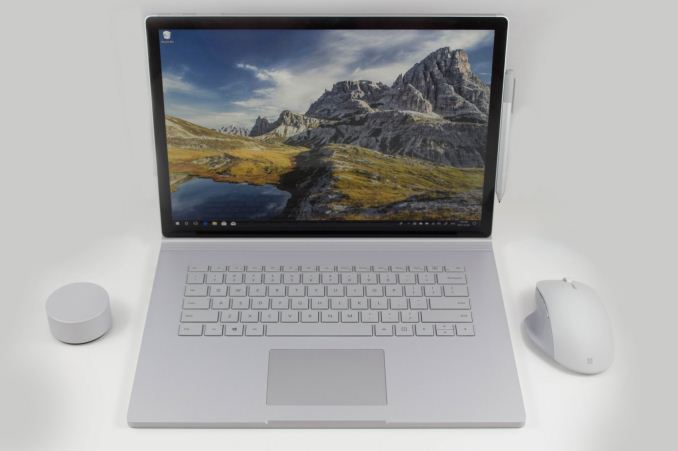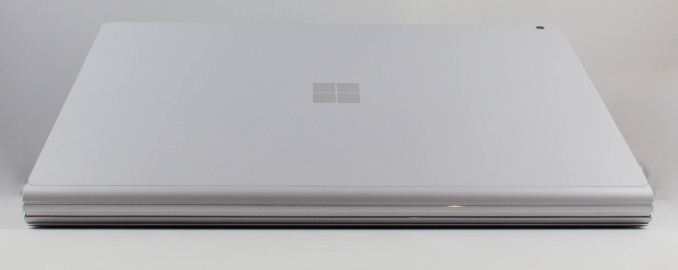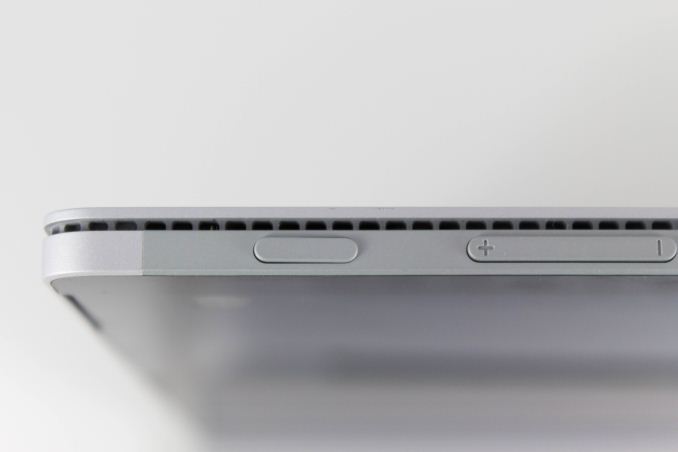The Microsoft Surface Book 2 (15-Inch) Review: Second Time's The Charm
by Brett Howse on December 21, 2017 8:00 AM EST- Posted in
- Laptops
- Microsoft
- Surface
- Pascal
- Surface Book
- Kaby Lake Refresh
Final Words
The Surface Book 2 is still one of the most unique device designs out there. The detachable display docks to a solid keyboard base, which offers a powerful GPU and plenty of battery. The extra capabilities add to a laptop that can be used in a lot of scenarios.
Microsoft has focused on bringing new device designs to market since they launched Surface, and it’s fair to say that the Surface Book 2 is more evolution than revolution, but it’s still a very unique design in the PC space that didn’t need a lot of tweaks. The interesting hinge allows for a more stable platform when used on a desk or in your lap, especially compared to most detachable tablets, which are far too top heavy.
There’s no question the choice of materials, and the attention to detail, make the Surface Book 2 stand apart. The all-metal design is wonderful to hold, with a great finish that resists fingerprints, and doesn’t feel slippery in the hand. The docking mechanism sounds, and works, great, but it’s hard to judge how it will stand up over time. The original Surface Book did have some docking connector issues over its lifespan, so hopefully these are resolved.
Making the Surface Book 2 bigger with the new 15-inch model doesn’t really make it feel much bigger than the 13.5-inch version, but there is even more desktop space available on the 3:2 aspect ratio display.
Speaking of the display, it’s a stunner. The 15-inch 3240x2160 resolution panel is calibrated at the factory for accuracy, and on the review unit we received, it is the most accurate display we’ve ever tested. The lack of a wide-gamut is a small knock against the Surface Book 2. A wider gamut would be nice, but until Windows gets a proper color management system, a proper sRGB mode is likely for the best. The enhanced mode does give a bit more pop if you need that, although it can’t replace a true P3 D65 display if you have the content to use it for. But thanks to the super accurate colors, and amazing contrast ratio, it would be hard to feel disappointed with this display.
Surface Book had a great keyboard, and fantastic trackpad, and both of those carry over to the new model. The size, texture, and feel of the trackpad easily make it one of the best available on a Windows PC today. The Precision drivers offer enough customization to get the job done, without adding bulk or confusion to the experience.
Every device has faults, and this one is no exception. The lack of Thunderbolt 3 on the USB-C port is a bit of a mystery on a premium notebook like this, and despite Microsoft claiming their issue with USB-C is port capability confusion, they’ve limited the port on their own device. Most people aren’t going to need to run high-speed storage, or multiple UHD displays, but for those that do, the Surface Book 2 is simply not an option for them thanks to this decision. Two years ago, it was questionable, but practically every other notebook in this segment offers Thunderbolt 3 now.
The second issue is not being able to supply enough power to cover the laptop’s demands under all situations. It’s not a huge issue, since even after 75 minutes of gaming the laptop had only dropped to 95% charge, but in order to do that, it had to drop performance a bit. Clearly the Surface Connect is at its power limit, and that’s a shame. There’s no elegant solution to this if Microsoft wants to keep their magnetic connector, which certainly has its benefits.
The final issue with the Surface Book 2 is the price. The smaller 13.5-inch model starts at $1500 with no GPU, although thankfully it does have 8 GB of memory, unlike the base model Surface Laptop and Surface Pro. But the 15-inch model being reviewed today starts at $2500 with just a 256 GB SSD. The 15-inch version does come standard with the Core i7-8650U and GTX 1060 though, as well as 16 GB of RAM, so even the base model is a stout computer. The jump to 512 GB costs an additional $400 though, and that’s just for the SSD upgrade. The 1 TB model is a staggering $3299. There’s no way to sugar coat this. The Surface Book 2 15-inch is very, very, expensive. A 14-inch Razer Blade UHD with a 1 TB SSD is a full $500 less, with the same GPU and a more powerful CPU, but still with an all-metal chassis.
But it’s not just about the components. Microsoft’s display is arguably the best in any notebook. The magnesium finish is fantastic. The design is interesting, and functional, and the versatility of the detachable display, even if only to flip it around to watch a movie on a plane, adds value to the device. When Surface Book launched in 2015, it was a new, fresh take. The 2017 model adds performance, refinement, and reliability, and is simply one of the best notebooks on the market today.














120 Comments
View All Comments
Peskarik - Thursday, December 21, 2017 - link
One BIG problem with all these contemporary thin machines is the built-in battery.First of all, the full charge capacity is always lower than the announced capacity (battery is like a human, ages right from the birth).
Secondly, battery looses capacity over the charging cycles, especially if one does 0-100% charges.
So, a year from purchase one does not have 85Wh anymore, most likely having lost 20% of that. And what do you do then? Replacing the battery, if even possible, is very expensive outlay (I suppose, I haven't done it yet, but only because I still use Thinkpad with fully replaceable battery).
zepi - Thursday, December 21, 2017 - link
Ageing of batteries is usually overblown if they are managed properly.For example my wife has a 3 years old Macbook Pro with close to 800 cycles on the battery and it still holds 85% of the original charge. Obviously there is degradation, but her usage is super hard, doing 100 to 0% deep discharges day in day out etc, despite my warnings that this is bad for the battery. This more or less aligns with my own experiences with other "unibody" Macbook Pro's that I've used over the years.
Despite having used macs with integrated batteries for about 10 years, I've never experienced one losing so much battery degradation that I would have even considered replacing a battery, with my wife's example being the worst.
Are PC laptops considerably worse in this regards? Normally 1000 cycles loses at most 20% of battery life and for modern laptops that is from 10h to 8 hours, which I don't think is such a disaster.
mkozakewich - Thursday, December 21, 2017 - link
I just ran a battery report, and my Surface Book 2 has got 109% battery health.Good companies know things will degrade a little, and they deal with it in a multitude of ways. My original Surface Pro still has about 80% of its battery after five years, and I expect the same from this.
Also, I get through a ten-hour day with nearly half my charge left, so I'll be perfectly fine with 20% less.
lucam - Thursday, December 21, 2017 - link
When the IPad Pro 2 review? .if is still part of your plans? Or will you wait till April by the time we gonna get the IPad Pro 2018?Ryan Smith - Thursday, December 21, 2017 - link
It's not on the schedule at this time.amdwilliam1985 - Thursday, December 21, 2017 - link
Here's a review for the iPad Pro 2.Best iPad [Pro] ever, buy it!
Merry Christmas :)
lucam - Friday, December 22, 2017 - link
Thank you...suppose same for iPhone X...merry xmas to you too..😁id4andrei - Friday, December 22, 2017 - link
Nope. The iphone X is starting to throttle down performance from the moment you buy it so it's a flawed device.lucam - Friday, December 22, 2017 - link
must be the reason why it hasn't been reviewed (here)...too hard to admit that...akdj - Sunday, December 31, 2017 - link
I’m completely with you lucam, 100%.Out of boredom, I read this one. We’re still ‘owed’ an A10 ‘deep dive’, haven’t seen a word on the updated (2 yrs ago) MacBook Pro, Apple Watch, iPhone or iPad.
Far cry from the ATech of old. I’m rarely here any more, all MoBo & power supply reviews makes for an extremely dull website to Ars veee go